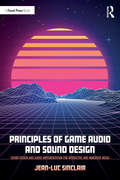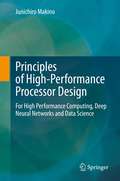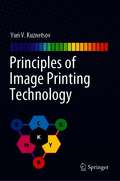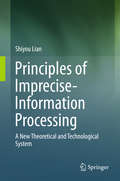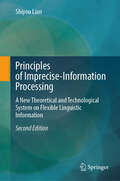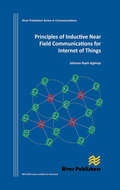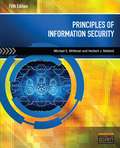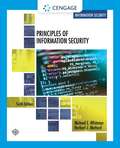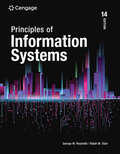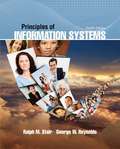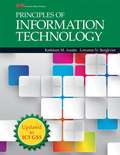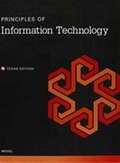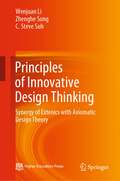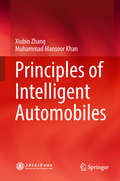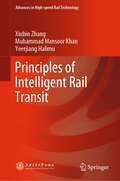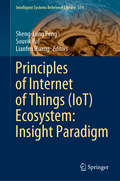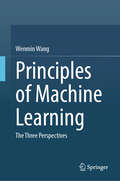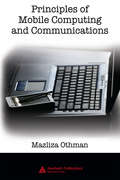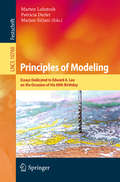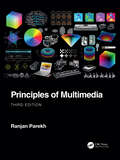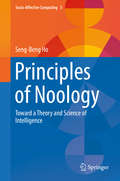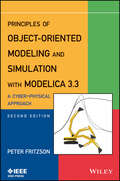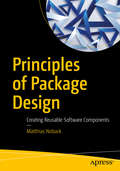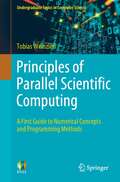- Table View
- List View
Principles of Digital Communication and Coding (Dover Books on Electrical Engineering)
by Jim K. Omura Andrew J. ViterbiWritten by two distinguished experts in the field of digital communications, this classic text remains a vital resource three decades after its initial publication. Its treatment is geared toward advanced students of communications theory and to designers of channels, links, terminals, modems, or networks used to transmit and receive digital messages.The three-part approach begins with the fundamentals of digital communication and block coding, including an analysis of block code ensemble performance. The second part introduces convolutional coding, exploring ensemble performance and sequential decoding. The final section addresses source coding and rate distortion theory, examining fundamental concepts for memoryless sources as well as precepts related to memory, Gaussian sources, and universal coding. Appendixes of useful information appear throughout the text, and each chapter concludes with a set of problems, the solutions to which are available online.
Principles of Game Audio and Sound Design: Sound Design and Audio Implementation for Interactive and Immersive Media
by Jean-Luc SinclairPrinciples of Game Audio and Sound Design is a comprehensive introduction to the art of sound for games and interactive media using Unity. This accessible guide encompasses both the conceptual challenges of the artform as well as the technical and creative aspects, such as sound design, spatial audio, scripting, implementation and mixing. Beginning with basic techniques, including linear and interactive sound design, before moving on to advanced techniques, such as procedural audio, Principles of Game Audio and Sound Design is supplemented by a host of digital resources, including a library of ready-to-use, adaptable scripts. This thorough introduction provides the reader with the skills and tools to combat the potential challenges of game audio independently. Principles of Game Audio and Sound Design is the perfect primer for beginner- to intermediate-level readers with a basic understanding of audio production and Unity who want to learn how to gain a foothold in the exciting world of game and interactive audio.
Principles of High-Performance Processor Design: For High Performance Computing, Deep Neural Networks and Data Science
by Junichiro MakinoThis book describes how we can design and make efficient processors for high-performance computing, AI, and data science. Although there are many textbooks on the design of processors we do not have a widely accepted definition of the efficiency of a general-purpose computer architecture. Without a definition of the efficiency, it is difficult to make scientific approach to the processor design. In this book, a clear definition of efficiency is given and thus a scientific approach for processor design is made possible. In chapter 2, the history of the development of high-performance processor is overviewed, to discuss what quantity we can use to measure the efficiency of these processors. The proposed quantity is the ratio between the minimum possible energy consumption and the actual energy consumption for a given application using a given semiconductor technology. In chapter 3, whether or not this quantity can be used in practice is discussed, for many real-world applications. In chapter 4, general-purpose processors in the past and present are discussed from this viewpoint. In chapter 5, how we can actually design processors with near-optimal efficiencies is described, and in chapter 6 how we can program such processors. This book gives a new way to look at the field of the design of high-performance processors.
Principles of Image Printing Technology
by Yuri V. KuznetsovPrinciples of Image Printing Technology is a unique review of technology use in the printing industry since the time of the medieval engravers and busy newsroom typesetters. It provides a historical review of the advancement of technology and describes in-depth both technical fundamentals and industrial procedures. Intended primarily for students in graphic communications programs, this book includes all the necessary background for understanding printing technology. In addition, by providing findings from basic research studies and industrial processes that have been omitted elsewhere in published volumes, it offers a useful guide to researchers and professionals in the printing industry.
Principles of Imprecise-Information Processing
by Shiyou LianThe book showcases cutting-edge concepts and methods, and presents the principle of imprecise-information processing. It also proposes a new theory and technology for imprecise-information processing that differs from fuzzy technology, thus providing a platform for related applications and laying the theoretical basis for further research. Imprecise-information processing - a type of processing based on flexible linguistic values and quantifiable rigid linguistic values - is an important component of intelligence science and technology. This book offers an easy-to-understand overview of the basic principles and methods of imprecise-information processing, allowing readers to develop related applications or pursue further research.
Principles of Imprecise-Information Processing: A New Theoretical and Technological System on Flexible Linguistic Information
by Shiyou LianThis book reveals the origin of imprecise information and establishes the mathematical models of flexible words and related mathematical and logical theories. It presents a set of models and algorithms of reasoning and computation, thus building a platform for related applications and laying a foundation for further research. Applying the theories and technologies in the book builds flexible AI systems to solve corresponding clustering, classification, judging, recognition, control, prediction, regression, etc., problems, and to enhance the Agent’s and Robot’s abilities to perceive environment and control behavior. Combine large language models (LLMs) with flexible linguistic information technologies in the book to enhance and extend the capability of natural language processing, and to realize understanding and generation of flexible words. This book differentiates imprecision from the uncertainty of information and explicitly treats imprecise-information processing as an independent subject. Imprecise-information processing is an indispensable research topic and branch field of artificial intelligence. With a new perspective and idea, the book starts from the origin of imprecise information, comprehensively and systematically expounds the principles, methods, and applications of imprecise-information processing, and establishes a new theoretical and technological system different from fuzzy technology on flexible linguistic information. The audience of this book includes scholars, engineers, teachers, Ph.D. candidates, postgraduates, and advanced undergraduates in the fields of artificial intelligence, natural language processing, Agent, Robot, automation, information, computer, logics, mathematics, language, as well as brain and cognitive science, etc.
Principles of Inductive Near Field Communications for Internet of Things
by Johnson I. AgbinyaNear field communication devices and the emerging field of Internet of things require efficient short range communication techniques. Classical telecommunication theory however has so far focused on radiating electromagnetic signals which is more suited to terrestrial communication systems. Over the last decade however considerable research and applications of inductive methods have emerged as innovative approaches for secure short range communications by changing the paradigm of an established model of electromagnetic communications. We have witnessed the emergence of embedded inductive medical devices, magneto-inductive waveguides, inductive pots and cooking devices, magneto-inductive sensors, wireless power transfer, inductive hearing aids and the emerging inductive point-to-point communication specifically termed near-field communication (NFC) as used in mobile phones and payment cards to name a few. While there exist a large set of distributed methods and algorithms detailing the design and performances of such applications, a significant gap is observed as a lack of detailed collection of the methods in one place which could be easily understood and used quickly by someone seeking to apply the methods.In this book this missing gap is filled with the required details and the theory of near field communication systems including both the radiating and reactive (energy coupling) near-field systems in addition to the well known far field radiation techniques. The book details the fundamental expressions and design methods which facilitate the creation of near field devices and equipment including embedded biomedical implants. The book contains recent advances in inductive communications, performance, limitations and a collection of applications. It also lays a strong foundation for the application of inductive methods for creating Internet of Things systems.
Principles of Information Security
by Michael E. Whitman Herbert J. MattordSpecifically oriented to the needs of information systems students, PRINCIPLES OF INFORMATION SECURITY, 5e delivers the latest technology and developments from the field. Taking a managerial approach, this bestseller teaches all the aspects of information security-not just the technical control perspective. It provides a broad review of the entire field of information security, background on many related elements, and enough detail to facilitate understanding of the topic. It covers the terminology of the field, the history of the discipline, and an overview of how to manage an information security program. Current and relevant, the fifth edition includes the latest practices, fresh examples, updated material on technical security controls, emerging legislative issues, new coverage of digital forensics, and hands-on application of ethical issues in IS security. It is the ultimate resource for future business decision-makers.
Principles of Information Security (MindTap Course List Series)
by Michael E. Whitman Herbert J. MattordPrinciples of Information Security, Sixth Edition, provides a broad review of the entire field of information security, background on many related elements, and enough detail to facilitate an understanding of the topic as a whole. The book covers the terminology of the field, the history of the discipline, and strategies for managing an information security program. You review terms used in the field and a history of the discipline as you learn how to manage an information security program. Current and relevant, this edition highlights the latest practices with fresh examples that explore the impact of emerging technologies, such as the Internet of Things, Cloud Computing, and DevOps. Updates address technical security controls, emerging legislative issues, digital forensics, and ethical issues in IS security, making this the ideal IS resource for business decision makers.
Principles of Information Systems
by Ralph M. Stair Mark Frydenberg George W. Reynolds Joey Bryant Hollis Greenberg George SchellDevelop an understanding of the core principles of information systems (IS) and how these principles make a difference in today's business environment with Stair/Reynolds' PRINCIPLES OF INFORMATION SYSTEMS, 14E. Completely reorganized for clarity and focus, this fresh new edition provides engaging new chapter opening cases and a new chapter on AI and automation. You explore the challenges and risks of cybercrime, hacking, internet of things, and artificial intelligence as you examine the latest IS research and learn from memorable examples. You can even maximize your employability as you learn how to use IS to increase profits and reduce costs in organizations. You study the latest in big data, business intelligence, cloud computing, e-commerce, enterprise systems, mobile computing, strategic planning, and systems development.
Principles of Information Systems (Twelfth Edition)
by Ralph Stair George ReynoldsEquipping you with a solid understanding of the core principles of IS and how it is practiced, PRINCIPLES OF INFORMATION SYSTEMS, 12E covers the latest research and developments from the field and their impact on the rapidly changing role of today's IS professional. The book includes expansive coverage of mobile solutions, energy and environmental concerns, cloud computing, IS careers, virtual communities, global IS work solutions, and social networking. You learn firsthand how information systems can increase profits and reduce costs as you explore new information on e-commerce and enterprise systems, artificial intelligence, virtual reality, green computing, and other issues reshaping the industry. The book also introduces the challenges and risks of computer crimes, hacking, and cyberterrorism. A long-running example illustrates how technology was used in the design, development, and production of this book. No matter where your career path may lead, PRINCIPLES OF INFORMATION SYSTEMS, 12E can help you maximize your success as an employee, a decision maker, and a business leader.
Principles of Information Technology
by Kathleen M. Austin Lorraine N. BergkvistPrinciples of Information Technology presents basic principles and concepts about information technology to help students become more valuable employees, better citizens, and knowledgeable consumers. Written specifically for high school students, this text maps to the IC3 Digital Literacy Certification standards. By studying this text, students can prepare for taking the Certiport IC3 Digital Literacy Certification exams. IC3 Digital Literacy Certification is a well-respected and internationally recognized credential.
Principles of Information Technology: Preparing for IC3 Certification
by Suzanne WeixelNIMAC-sourced textbook
Principles of Innovative Design Thinking: Synergy of Extenics with Axiomatic Design Theory
by C. Steve Suh Zhenghe Song Wenjuan LiThe book presents a comprehensive treatment on a novel design theory that fosters innovative thinking and creativity essential for addressing wicked problems. Wicked problems are ill-defined, ambiguous in both aims and solutions, and complex with interconnected and intertwined (coupled) factors. While being ubiquitous and difficult, however, wicked problems share characteristics common to science and design in three regards, namely agent finitude, system complexity, and problem normativity. These fundamental attributes allow a core cognitive process common to design and science to be identified and a strategic problem-solving conception of methodology be formulated as a result. The theory facilitates new opportunities for synergetic cross-disciplinary research and practice by incorporating the essences of Extenics to axiomatic design. Innovative thinking is enabled by exploring Extenics for problem reframing, paradigm shift, and abductive reasoning and by engaging axiomatic design in the co-evolution (iteration) of the need and viable design concept. The theory is unique in that it is a framework for quantifying imprecise and vague design information available during the conceptual design stage as mathematical expression and algorithm early in the design effort and enables the objective evaluation and emergence of an optimal design concept from among multitude of viable ones. The book is conceived for students and real-world practitioners in engineering, natural and social sciences, business, and fine arts who seek to develop powerful design thinking for solving problems in a creative and innovative way.
Principles of Intelligent Automobiles
by Xiubin Zhang Muhammad Mansoor KhanThis book discusses the principle of automotive intelligent technology from the point of view of modern sensing and intelligent control. Based on the latest research in the field, it explores safe driving with intelligent vision; intelligent monitoring of dangerous driving; intelligent detection of automobile power and transmission systems; intelligent vehicle navigation and transportation systems; and vehicle-assisted intelligent technology. It draws on the author’s research in the field of automotive intelligent technology to explain the fundamentals of vehicle intelligent technology, from the information sensing principle to mathematical models and the algorithm basis, enabling readers to grasp the concepts of automotive intelligent technology. Opening up new scientific horizons and fostering innovative thinking, the book is a valuable resource for researchers as well as undergraduate and graduate students.
Principles of Intelligent Rail Transit (Advances in High-speed Rail Technology)
by Xiubin Zhang Muhammad Mansoor Khan Yeerjiang HalimuThis book systematically expounds on the scientific principles and technologies of Rail Transit Intelligent Technology based on the high development of artificial intelligence theory and technology. The contents include technical principles, theoretical algorithms and practical engineering technologies of intelligent monitoring of rail transit system, intelligent sensing and identification of train power system, intelligent technology in rail transit system operation, intelligent maintenance of carriage environment, etc. It can be used as a textbook or teaching reference book for related fields in universities, including rail transit system, communication, automation, intelligent equipment design and manufacturing, artificial intelligence, computer science and technology, electrical engineering and automation, etc. It is used as an academic reference for professionals in rail transit system design, operation, and maintenance.
Principles of Internet of Things (Intelligent Systems Reference Library #174)
by Sheng-Lung Peng Souvik Pal Lianfen HuangThis book discusses the evolution of future-generation technologies through the Internet of things, bringing together all the related technologies on a single platform to offer valuable insights for undergraduate and postgraduate students, researchers, academics and industry practitioners. The book uses data, network engineering and intelligent decision- support system-by-design principles to design a reliable IoT-enabled ecosystem and to implement cyber-physical pervasive infrastructure solutions. It takes readers on a journey that begins with understanding the insight paradigm of IoT-enabled technologies and how it can be applied. It walks readers through engaging with real-time challenges and building a safe infrastructure for IoT-based, future-generation technologies. The book helps researchers and practitioners to understand the design architecture through IoT and the state of the art in IoT countermeasures. It also highlights the differences between heterogeneous platforms in IoT-enabled infrastructure and traditional ad hoc or infrastructural networks, and provides a comprehensive discussion on functional frameworks for IoT, object identification, IoT domain model, RFID technology, wearable sensors, WBAN, IoT semantics, knowledge extraction, and security and privacy issues in IoT-based ecosystems. Written by leading international experts, it explores IoT-enabled insight paradigms, which are utilized for the future benefit of humans. It also includes references to numerous works. Divided into stand-alone chapters, this highly readable book is intended for specialists, researchers, graduate students, designers, experts, and engineers involved in research on healthcare-related issues.
Principles of Machine Learning: The Three Perspectives
by Wenmin WangConducting an in-depth analysis of machine learning, this book proposes three perspectives for studying machine learning: the learning frameworks, learning paradigms, and learning tasks. With this categorization, the learning frameworks reside within the theoretical perspective, the learning paradigms pertain to the methodological perspective, and the learning tasks are situated within the problematic perspective. Throughout the book, a systematic explication of machine learning principles from these three perspectives is provided, interspersed with some examples. The book is structured into four parts, encompassing a total of fifteen chapters. The inaugural part, titled “Perspectives,” comprises two chapters: an introductory exposition and an exploration of the conceptual foundations. The second part, “Frameworks”: subdivided into five chapters, each dedicated to the discussion of five seminal frameworks: probability, statistics, connectionism, symbolism, and behaviorism. Continuing further, the third part, “Paradigms,” encompasses four chapters that explain the three paradigms of supervised learning, unsupervised learning, and reinforcement learning, and narrating several quasi-paradigms emerged in machine learning. Finally, the fourth part, “Tasks”: comprises four chapters, delving into the prevalent learning tasks of classification, regression, clustering, and dimensionality reduction. This book provides a multi-dimensional and systematic interpretation of machine learning, rendering it suitable as a textbook reference for senior undergraduates or graduate students pursuing studies in artificial intelligence, machine learning, data science, computer science, and related disciplines. Additionally, it serves as a valuable reference for those engaged in scientific research and technical endeavors within the realm of machine learning. The translation was done with the help of artificial intelligence. A subsequent human revision was done primarily in terms of content.
Principles of Mobile Computing and Communications
by Mazliza OthmanMobile computing technology has come a long way in recent years-providing anytime, anywhere communication and access to information. Bringing students up to date on important technological and industry developments, Principles of Mobile Computing and Communications examines mobile networks and relevant standards, highlighting issues unique to the m
Principles of Modeling: Essays Dedicated to Edward A. Lee on the Occasion of His 60th Birthday (Lecture Notes in Computer Science #10760)
by Marjan Sirjani Marten Lohstroh Patricia DerlerThis Festschrift is published in honor of Edward A. Lee, Robert S. Pepper Distinguished Professor Emeritus and Professor in the Graduate School in the Department of Electrical Engineering and Computer Sciences at the University of California, Berkeley, USA, on the occasion of his 60th birthday.The title of this Festschrift is “Principles of Modeling" because Edward A. Lee has long been devoted to research that centers on the role of models in science and engineering. He has been examining the use and limitations of models, their formal properties, their role in cognition and interplay with creativity, and their ability to represent reality and physics. The Festschrift contains 29 papers that feature the broad range of Edward A. Lee’s research topics; such as embedded systems; real-time computing; computer architecture; modeling and simulation, and systems design.
Principles of Multimedia
by Ranjan ParekhPrinciples of Multimedia introduces and explains the theoretical concepts related to the representation, storage, compression, transmission and processing of various multimedia components, including text, image, graphics, audio, video and animation, as well as their use across various applications. The book provides the necessary programming tools and analysis technique concepts to perform practical processing tasks in software labs and to solve numerical problems at the postgraduate level. For this new third edition, every chapter has been updated and the book has been carefully streamlined throughout.Chapter 1 provides an overview of multimedia technology, including the definition, major characteristics, hardware, software, standards, technologies and relevant theorems with mathematical formulations. Chapter 2 covers text, including digital text representations, text editing and processing tools, text application areas and text file formats. Chapter 3 explores digital image input and output systems, image editing and processing tools, image application areas, image color management and image file formats. Chapter 4 discusses 2D and 3D graphics algorithms, transformation matrices, splines, fractals, vectors, projection application areas and graphics file formats. Chapter 5 covers audio, including digital audio input and output systems, audio editing and processing tools, audio application areas and audio file formats. Chapter 6 looks at video, including digital video input and output systems, video editing and processing tools, video application areas and video file formats. Chapter 7 focuses on animation, covering 2D and 3D animation algorithms, interpolations, modeling, texture mapping, lights, illumination models, camera, rendering, application areas and animation file formats. Finally, Chapter 8 covers compression, including lossless and lossy compression techniques, and various algorithms related to text image audio and video compression. Every chapter includes solved numerical problems, coding examples and references for further reading.Including theoretical explanations, mathematical formulations, solved numerical problems and coding examples throughout, Principles of Multimedia is an ideal textbook for graduate and postgraduate students studying courses on image processing, speech and language processing, signal processing, video object detection and tracking, graphic design and modeling and related multimedia technologies.
Principles of Noology
by Seng-Beng HoThe idea of this book is to establish a new scientific discipline, "noology," under which a set of fundamental principles are proposed for the characterization of both naturally occurring and artificial intelligent systems. The methodology adopted in Principles of Noology for the characterization of intelligent systems, or "noological systems," is a computational one, much like that of AI. Many AI devices such as predicate logic representations, search mechanisms, heuristics, and computational learning mechanisms are employed but they are recast in a totally new framework for the characterization of noological systems. The computational approach in this book provides a quantitative and high resolution understanding of noological processes, and at the same time the principles and methodologies formulated are directly implementable in AI systems. In contrast to traditional AI that ignores motivational and affective processes, under the paradigm of noology, motivational and affective processes are central to the functioning of noological systems and their roles in noological processes are elucidated in detailed computational terms. In addition, a number of novel representational and learning mechanisms are proposed, and ample examples and computer simulations are provided to show their applications. These include rapid effective causal learning (a novel learning mechanism that allows an AI/noological system to learn causality with a small number of training instances), learning of scripts that enables knowledge chunking and rapid problem solving, and learning of heuristics that further accelerates problem solving. Semantic grounding allows an AI/noological system to "truly understand" the meaning of the knowledge it encodes. This issue is extensively explored. This is a highly informative book providing novel and deep insights into intelligent systems which is particularly relevant to both researchers and students of AI and the cognitive sciences.
Principles of Object-Oriented Modeling and Simulation with Modelica 3.3
by Peter FritzsonFritzson covers the Modelica language in impressive depth from the basic concepts such as cyber-physical, equation-base, object-oriented, system, model, and simulation, while also incorporating over a hundred exercises and their solutions for a tutorial, easy-to-read experience.The only book with complete Modelica 3.3 coverageOver one hundred exercises and solutionsExamines basic concepts such as cyber-physical, equation-based, object-oriented, system, model, and simulation
Principles of Package Design: Creating Reusable Software Components
by Matthias NobackApply design principles to your classes, preparing them for reuse. You will use package design principles to create packages that are just right in terms of cohesion and coupling, and are user- and maintainer-friendly at the same time.The first part of this book walks you through the five SOLID principles that will help you improve the design of your classes. The second part introduces you to the best practices of package design, and covers both package cohesion principles and package coupling principles. Cohesion principles show you which classes should be put together in a package, when to split packages, and if a combination of classes may be considered a "package" in the first place. Package coupling principles help you choose the right dependencies and prevent wrong directions in the dependency graph of your packages.What You'll LearnApply the SOLID principles of class designDetermine if classes belong in the same packageKnow whether it is safe for packages to depend on each otherWho This Book Is ForSoftware developers with a broad range of experience in the field, who are looking for ways to reuse,share, and distribute their code
Principles of Parallel Scientific Computing: A First Guide to Numerical Concepts and Programming Methods (Undergraduate Topics in Computer Science)
by Tobias WeinzierlNew insight in many scientific and engineering fields is unthinkable without the use of numerical simulations running efficiently on modern computers. The faster we get new results, the bigger and accurate are the problems that we can solve. It is the combination of mathematical ideas plus efficient programming that drives the progress in many disciplines. Future champions in the area thus will have to be qualified in their application domain, they will need a profound understanding of some mathematical ideas, and they need the skills to deliver fast code. The present textbook targets students which have programming skills already and do not shy away from mathematics, though they might be educated in computer science or an application domain. It introduces the basic concepts and ideas behind applied mathematics and parallel programming that we need to write numerical simulations for today’s multicore workstations. Our intention is not to dive into one particular application domain or to introduce a new programming language – we lay the generic foundations for future courses and projects in the area. The text is written in an accessible style which is easy to digest for students without years and years of mathematics education. It values clarity and intuition over formalism, and uses a simple N-body simulation setup to illustrate basic ideas that are of relevance in various different subdomains of scientific computing. Its primary goal is to make theoretical and paradigmatic ideas accessible to undergraduate students and to bring the fascination of the field across.

